Which is better, non-woven or vinyl wallpaper: advantages and disadvantages + subtleties of choosing wallpaper
Wallpaper is often used to cover walls and ceilings in residential apartments, houses and offices.Do you agree that renovations are not done for a single year and not only beauty is important, but also practicality and durability of the finish? Therefore, you need to look at the composition and characteristics of the facing material.
Both non-woven and vinyl wallpapers are popular. Each of these types has its own characteristics, pros and cons. It is important to know about them in order to understand what is better, non-woven or vinyl wallpaper for a particular room.
In the article we will characterize each type of finishing material, highlight its advantages and disadvantages, and conduct a comparative analysis. We'll tell you what is best to use and in what cases. We will give general advice on choosing.
The content of the article:
Why is it important to know the characteristics of the material?
The performance characteristics and properties of wallpaper directly depend on the material from which they are made.
Externally, non-woven and vinyl sheets are similar. But they have different levels of resistance to ultraviolet radiation, moisture and mechanical damage. They are distinguished by their structure, environmental friendliness, vapor permeability, and fire resistance. These points must be taken into account and correlated with the parameters and features of the room.
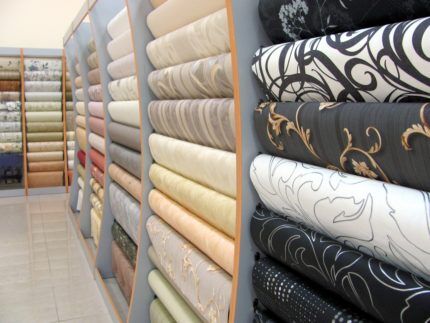
If you paste wallpaper that has low UV resistance into a sunny room, it will fade very quickly and you will have to change it again. If you decorate the walls of a room with high humidity with canvases that do not react well to contact with water, this will lead to a quick loss of the presentable appearance of the cladding.
In rooms with a poor microclimate, due to vapor-tight wallpaper, fungus and mold will appear. Spores of these microorganisms easily penetrate the human body, causing various pathological conditions: allergies, poisoning, asthma, oncology, etc.
If you choose the right facing material, it will last as long as possible and will not cause harm to health.
Characteristics of non-woven wallpaper
Non-woven wallpaper is made from cellulose and polyester. Like paper ones, they are characterized by uniformity and environmental friendliness. But at the same time more durable.
Non-woven wallpaper is created using non-woven fabric production technology. The material is dense and soft.
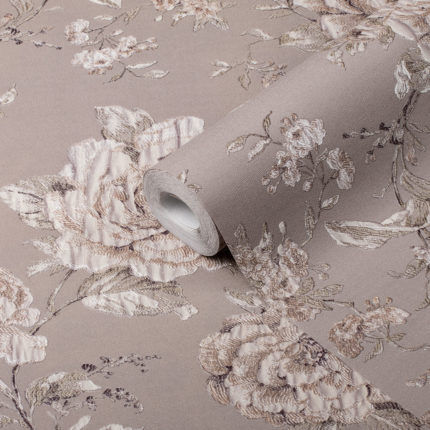
Based on appearance and texture, non-woven wallpaper is divided into smooth and embossed. The former are distinguished by their homogeneity, smooth surface, they combine perfectly with photo wallpaper, which allows even the most daring design ideas to be realized.
The outer side of structural wallpaper has an ordered or chaotic three-dimensional pattern. Such canvases look more stylish and expensive.
Advantages of finishing material
The main advantage of non-woven wallpaper is safety.Formaldehyde-containing compounds and other harmful substances are not used for applying patterns and gluing layers of fabric. Therefore, you don’t have to worry about your health.
For allergy sufferers, the only risk is dust that settles and accumulates on the textured surface of the wallpaper. If smooth sheets are used, this danger disappears.
This facing material is high-quality and modern and meets all fire safety requirements. In case of fire it does not release toxic compounds.
Non-woven wallpaper does not wrinkle, does not tear, and does not become soggy from glue. They do not shrink or become deformed after drying. Therefore, you don’t have to worry about gaps appearing between the canvases on the wall.
This finishing material is dense and hides minor irregularities well. There is no need to level the surface before gluing it.
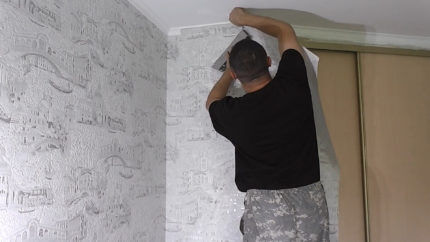
A special feature of non-woven wallpaper is that it does not need to be removed if you want to change the finish. They stick quite firmly to the wall. You can glue other wallpapers on top of them.
Non-woven products are durable. When using high-quality glue and following cladding technology, the canvas will last 8-10 years. A big advantage of the material is the possibility of painting. It allows you to strengthen the relief of the canvas and quickly transform the room. Non-woven wallpaper can be repainted several times, this will not deteriorate its performance parameters and appearance.
Another important advantage is good vapor permeability. Non-woven wallpaper has micropores through which air passes freely.Walls lined with this material “breathe.” Fungus and mold will not appear on them.
Disadvantages of non-woven fabric
In addition to the positive aspects, non-woven wallpaper also has its disadvantages. The main one is low resistance to mechanical damage. Even a light touch from a sharp or hard object can leave a mark on the canvas.
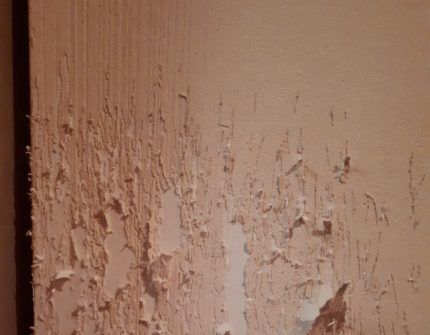
Non-woven wallpaper gets dirty easily. Contamination is difficult to remove. This material only withstands dry cleaning.
You cannot wash non-woven wallpaper with a brush or chemical solutions. As a result, the canvas will quickly lose its performance properties and attractive appearance. If the stain cannot be removed with a dry cloth, then a slightly damp sponge can be used. Dirt must be removed carefully. Do not rub the surface.
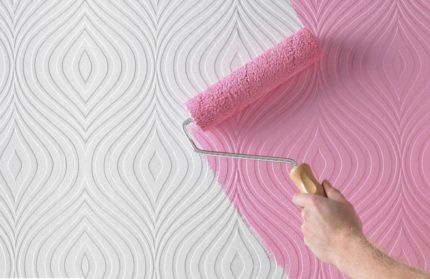
You can increase the resistance of non-woven wallpaper to water and mechanical damage by applying a layer of paint. Various compositions are suitable.
The method of care after painting is selected taking into account what type of paint was used. But you need to take into account that after such treatment, the surface of the wallpaper will become less permeable to air. Therefore, fungus formation is possible and black mold.
The disadvantages of non-woven material include the rapid absorption of odors. Therefore, such wallpaper cannot be called practical. In addition, they are quite expensive.The high price is associated not so much with their naturalness and safety, but with the complex production process.
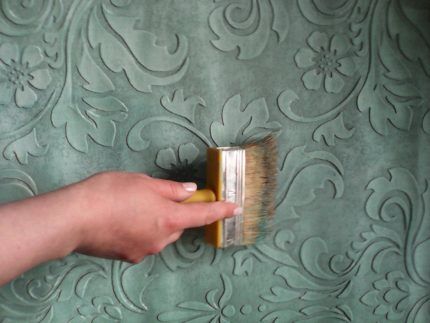
The choice of colors and textures of non-woven wallpaper is meager. With their help it will not be possible to create an imitation of wood, brick or stone.
Such canvases are unlikely to be suitable for implementing complex design solutions. At the same time, non-woven wallpaper, even with a modest pattern, looks very modern and stylish.
Characteristics of vinyl wallpaper
Vinyl wallpaper is a synthetic material. They consist of two layers. The lower part is made of non-woven fabric or paper. The top layer of the canvas, regardless of the type of base, is represented by polyvinyl chloride film.
This is plastic obtained through a chemical reaction. It is a product of oil refining. But this does not mean that vinyl wallpaper is toxic. If you follow the production technology and all standards, you can be confident in their safety. PVC film can be applied by foaming or hot stamping. This affects the characteristics of the product.
Advantages of finishing material
The main advantage of vinyl wallpaper, regardless of the method of its manufacture, is practicality. Such fabrics are durable, resistant to mechanical damage and wear.
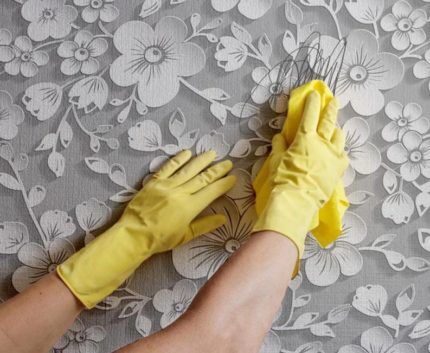
Vinyl wallpaper is characterized by increased water resistance. They can be cleaned using soapy water or detergents. They are not sensitive to chemicals and organic solvents. They can be rubbed with a brush to remove dirt.
Vinyl wallpaper on a non-woven base is distinguished by its ability to withstand deformation. This is especially true for new homes, which may experience natural shrinkage in the first couple of years.
The facing material retains its presentable appearance for a long time. It does not fade in the sun. Service life exceeds 10 years.
An important advantage of vinyl wallpaper is its elasticity and flexibility. This simplifies the gluing process. The material, despite its high density, easily bends around irregularities and corners. In some places it can be stretched a little if necessary.
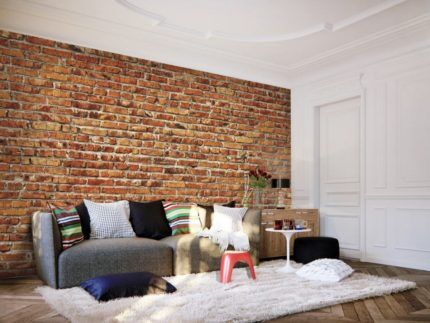
Vinyl wallpaper is available for sale in a wide range of colors, patterns and textures. There are options that imitate brick, stone, decorative plaster, etc. With the help of such facing material it is easy to implement any design solutions.
Disadvantages of vinyl fabric
The main disadvantage of vinyl wallpaper is its inability to allow air and steam to pass through. Polyvinyl chloride film tightly retains moisture under the surface, which is formed during temperature changes. Because of this, the walls are often covered with mold and mildew. But such a disadvantage can be combated.
Experts recommend treating walls before covering with vinyl material. deep penetration primer. This will prevent the formation and accumulation of condensation and eliminate the likelihood of mold and mildew. The main thing is that the primer is of high quality. It must be applied in a thick layer.
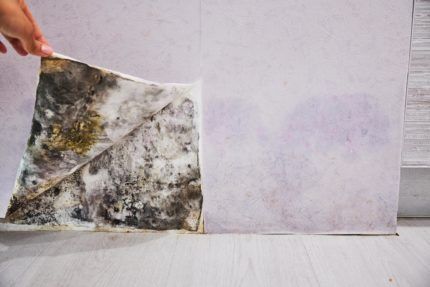
In apartments completely covered with vinyl wallpaper, stale air is often observed. This is due to the density of the PVC layer, which does not allow the walls to breathe. To avoid the appearance of an unpleasant odor, the room should be ventilated as often as possible.
Another disadvantage of vinyl wallpaper is its heavy weight. They create additional load on the walls. For load-bearing structures this disadvantage is irrelevant. But for thin ones plasterboard partitions It is not recommended to glue vinyl sheets.
An important disadvantage of this type of wallpaper is that it is not environmentally friendly. However, they contain PVC. There is still debate about their toxicity. Low quality products should be a concern. There is cladding material made from evaporated polyvinyl chloride on sale. During its production, all harmful components are removed from PVC.
Some people have difficulty installing vinyl wallpaper. It is not customary to join thick strips. Paper-based canvases shrink after drying. As a result, noticeable gaps are formed.

The disadvantages of this material include low fire resistance. When PVC burns, it releases toxic substances. Therefore, it is not recommended to cover the walls of a room characterized by low fire safety with vinyl wallpaper.
Features of choosing wallpaper
When choosing the type of wallpaper, you need to take into account the purpose of the room, the presence of small children and pets in the family. For rooms where people sleep and spend the most time, it is better not to choose vinyl cladding material.
It is strongly recommended to cover children's rooms with non-woven wallpaper. They should also be used for decorating bedrooms. But, if the room is well ventilated, then you can create a unique design using vinyl covering.
If the family has pets, then it is not advisable to cover it with non-woven wallpaper. Paw marks and scratches will appear on them very quickly. You need to use vinyl products and take care of organizing an optimal microclimate.
The bathroom is sometimes also covered with wallpaper. It is better to choose vinyl products for gluing. Finishing should be carried out after preliminary priming.
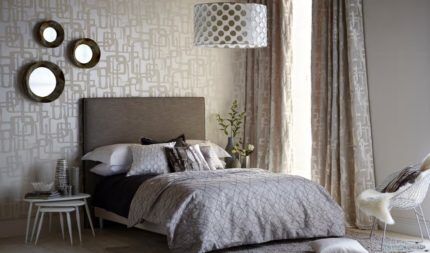
Any type of wallpaper is suitable for the living room. In the kitchen, hallway and corridor, it is better to glue vinyl sheets, the top layer of which is created using hot stamping.
Correctly selected wallpaper can change a room beyond recognition. In order for the facing material to serve for many years, you need to know and take into account a number of criteria when choosing it.
It is worth paying attention to the following points:
- company manufacturer;
- presence of odor;
- quality of paint application;
- presence of markings.
It is worth buying wallpaper from trusted and well-known manufacturers. Otherwise, you can purchase quite toxic and short-lived products. Wallpaper should not have an unpleasant synthetic odor. If it is present, then this indicates the presence of toxic substances in the composition.
It is important that durable paint is used in the production of wallpaper. Otherwise, the canvas will quickly fade. You can check the quality of the paint using a simple test. You need to take a piece of white paper and run it over the surface of the wallpaper. If a trace remains, it is better to refuse to purchase such a product. You also need to pay attention to the uniformity of paint application.
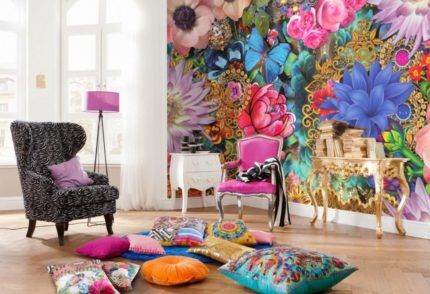
The roll must be marked “Quality Standard” or “ISO”. This marking indicates the high quality and safety of the product.
Before you go shopping for wallpaper, it is recommended to decide on its texture, style, and color. It is necessary to take into account the area of the room and the height of the ceiling. It is important to decide who will do the tiling: a team of craftsmen or the apartment residents personally.
It has been proven that each color affects a person’s emotional and psychological state. Blue has a calming effect on the nervous system. It is recommended to glue wallpaper in these shades in bedrooms, offices and study rooms. Red has a stimulating effect on the central nervous system and can cause headaches and aggression. Therefore, you should not choose this color for rest rooms.
Green relaxes and focuses. This is an ideal option for bedrooms and offices. Yellow color puts you in a positive mood. It increases physical activity and increases appetite. It is recommended to glue wallpaper in yellow shades in children's rooms and in the kitchen.
Brown color has the ability to create a cozy atmosphere. But in large quantities it causes negative emotions. Black is ideal for adding accents. The white shade visually expands the room and makes it more airy. Suitable for all types of rooms.
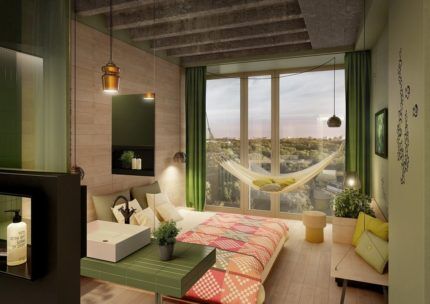
For small rooms, it is better to choose wallpaper with a horizontal pattern. This will visually expand the space. If the room is not sunny, then you should buy facing material of a light shade.
When covering the ceiling, it is better to give preference to white or beige wallpaper. The canvas can be plain or with a delicate pattern. When purchasing wallpaper with a pattern, you should take into account that you will have to adjust it to the walls when gluing it. This will increase consumption and complicate cladding.
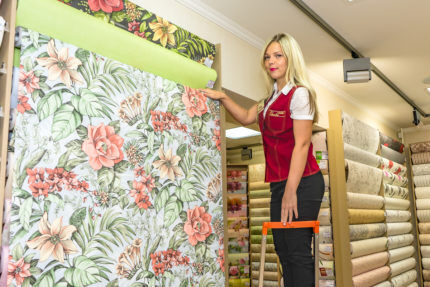
If you decide to glue wallpaper yourself, but have poor technical skills, then it is better to stick to non-woven varieties. They are easier to use.
Conclusions and useful video on the topic
Non-woven wallpaper versus vinyl. Experiments and comparison based on safety criteria:
What wallpaper to choose for a children's room.Non-woven or vinyl: technical recommendations:
Tips for choosing safe wallpaper:
There is no universal wallpaper that is suitable for any room. Each variety has its own advantages and disadvantages. It is important to know about them and select the facing material taking into account the characteristics of the room. For bedrooms and children's rooms, it is advisable to take non-woven wallpaper, and for the kitchen, bathroom, and corridor - vinyl.
If the walls of your apartment are lined with vinyl or non-woven wallpaper, then leave your opinion on the use of this finishing material. We will also be glad if you share your knowledge and experience regarding choosing wallpaper, checking its quality, etc. The comment form is located below.



